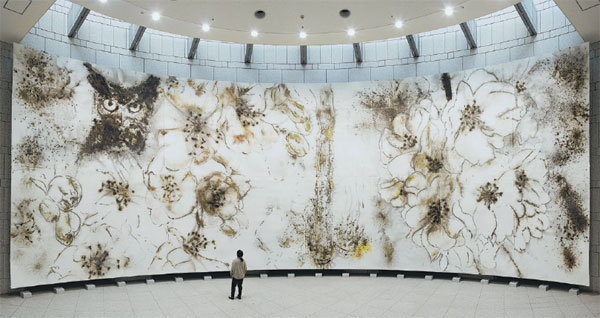Cai Guoqiang’s gunpowder art explodes on canvas
 0 Comment(s)
0 Comment(s) Print
Print E-mail China Daily, August 4, 2015
E-mail China Daily, August 4, 2015
| Nighttime Sakura, an 8-by-24-meter gunpowder work by Chinese contemporary artist Cai Guoqiang, is on shown at Yokohama Museum of Art in Japan. [Photos Provided to China Daily] |
A New York-based Chinese artist returns to this part of the world with a gunpowder show, Lin Qi reports.
Nighttime Sakura, a gunpowder artwork, is perhaps the largest of its kind to have been attempted by Cai Guoqiang to date.
The 58-year-old Chinese contemporary artist, who is based in New York, is presenting the painting of 8 by 24 meters, as the centerpiece of his ongoing solo exhibition, There and Back Again, at Yokohama Museum of Art in Japan.
A native of Quanzhou in eastern China's Fujian province, Cai started to experiment with gunpowder art while still in China but developed his own style during a nine-year stay in Japan.
"Many Japanese artists spent their lifetime in creating a perfect work of sakura (cherry blossom). I also wanted to have a try but with the explosive power of gunpowder," he tells Chinese media through an e-mail about the exhibition.
Talking of his vast piece at the show, Cai adds that the flower looks fragile, but its beauty becomes even more precious owing to how short-lived it is.
"Is it possible to re-create the blossom by violently exploding something? And, whether the momentary explosion of the powder can manifest into the enduring charm of sakura? I couldn't help but wonder."
The production process of the artwork turned out to be bumpy. The various types of Japanese gunpowder have little impurity and after being ignited, leave almost no explosive trail. The explosions didn't extensively produce the effect of gradual smudging on traditional Japanese paper.
It dismayed Cai so much that he converted his struggles into an emotional series of gunpowder paintings titled Seasons of Life that's also on display at the present exhibition.
The artist was inspired by shunga, the Japanese erotic art, to conduct a dialogue between vivid colors and desire in his works. He drew in the center of each painting a nude couple, giving man and woman a neutral look; he tattooed on their bodies images of Japanese gambling tools; he surrounded them with sketches of various animals and plants in the four seasons, implying the different stages in a relationship.







Go to Forum >>0 Comment(s)